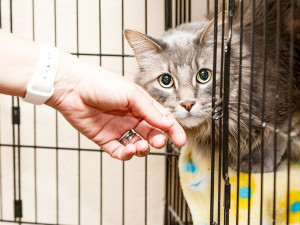3 College Students on How Fostering Pets Helped Them Get Through School
Plus, tips on how to make it work with term papers, exams, and a busy social life.
Dorm-room ramen, loft beds, three-hour written exams, and late nights out — these things are all part of how we imagine the quintessential college student experience. But while many university attendees are missing their family pets at home, a few have discovered a creative solution: fostering pets. While taking on the responsibility for another living creature may be the last thing on many students’ minds, others find the experience to be a rewarding and fulfilling part of their college years.
In fact, a 2021 study opens in new tab even found that the presence of cats on college campuses can greatly increase happiness levels among students. In fact, Stephens College, a private women’s college in Columbia, Missouri, is so aware of this that they offer a scholarship program opens in new tab through local rescue Columbia Second Chanceopens in new tab, so students can foster pets in their dorm roomsopens in new tab.
Students who get selected for the program go through a selection process, and if they are chosen, they get a scholarship to help care for the pets, as well as supplies provided by Second Chance. Even if students aren’t part of the program, Second Chance supports its college-student foster volunteers with the resources they need to take care of rescue animals. A rescue in a town with more than 36,000 opens in new tab college students, Second Chance is a great example of how organizations can utilize students — who have the energy and passion — to fulfill their foster needs.
But fostering in college can’t be easy, as anyone who’s ever had term-paper deadlines and group projects might imagine. Between daunting class schedules, tight budgets, and balancing time with friends, a few college fosters at Second Chance shared their experience with us.
How much do you spend on your pet per year?
What does it take to foster pets in college?
Torre Taylor grew up around animals, but didn’t bring a pet to college with her. During her second year of undergraduate studies, she had some extra time and decided to help out the local shelter by volunteering to walk dogs. She did this a few times, but she didn’t find out about the opportunity to foster dogs at Second Chance until graduate school, at which point she applied and brought home her first foster dog.
During her two-year tenure as a student foster, Taylor says “the biggest challenge was making time for vet appointments, meet-and-greets, and other events.” She remembers having to take off work early on occasion to make sure her fosters were taken care of — whether that meant picking them up from spay/neuter surgery, dropping them off at an adoption event, or taking them to meet a potential adopter. Luckily, she was able to ask roommates and friends for help when needed and coordinate with other volunteers when she wasn’t able to work around her other obligations.
Taylor also emphasizes the fact that fostering (and all the necessary supplies that accompany the task) is free, meaning that students on a budget can typically still make it work financially. This is a big deal to college students; pet-parenthood expenses can add up fast. While Taylor did pay for gas to drive to many adoption events, these were optional and when times were tight, she could keep her foster at home and find other ways to expose her to the public.
There are ways to get around the barriers to fostering.
A volunteer for Second Chance starting at age 10, Ellie Nixon started off earning credit for a school project but soon found herself begging her mom to let her continue her work with the rescue. She started fostering at just 17 years old, and has since then, she’s fostered 30 cats (one of whom she adopted, or as we say in the rescue world “foster failed”).
�“The biggest struggle I’ve had fostering is the fear of the animals going to a bad home, or seeing what happens to your fosters that get returned,” Nixon says.
In fact, according to the National Library of Medicineopens in new tab, up to 20 percent of adopted animals are returned to the shelter just six months after being adopted. This can pose a challenge for foster parents who have already taken in another pet and feel torn between their current commitment and a previous pet who needs help again.
“As far as college struggles go, finances have really never been an issue since the rescue provides everything the animals may need,” Nixon says. “You also have an entire network of volunteers that can help pick up, drop off, and more, so scheduling also isn’t the biggest concern.”
Even while many shelters and rescues have large networks of support and volunteers, though, some aspects of fostering remain a challenge. Nixon was required to pay a pet fee for her rental housing. These typically non-refundable deposits generally range from $200 to 500, and many rental properties charge additional rent for having pets, too. Pro tip from the writer (a former property manager): Let your landlord know you’re fostering and ask them if they’re willing to make any exceptions. Some might waive fees or deposits or only charge pet rent if you agree to pay for any damages caused by the animals at the end of your lease.
Nixon’s biggest piece of advice? Try to prepare yourself for the tough times. “It’s a rewarding experience more than anything else, but I wish I had better prepared myself for the hard times I’ve seen these animals go through. That’s why it’s so important for people like us to be here for them.”
Make sure you take on a foster who’s a good fit for you as you get started.
Ally, who asked for her last name not to be shared, grew up around dogs and was taught from a young age that animals are an important part of life. “I always went to the vet with my parents when I was a little girl, and I thought it was heaven on earth,” she says. “I quickly started volunteering at an animal hospital and a local shelter once I was old enough.” Soon after that, she got her first job at an animal clinic.
At 22, she got her first foster, a dog who had been surrendered to Second Chance after falling on hard times. This experience taught her to be open-minded and understand that these pets might come with a lot of baggage. “The first few weeks are always the hardest since they need time to settle in and require the most time learning their personalities.”
Ally suggests that new fosters begin with an easier animal, like a puppy or kitten who’ll be adopted quickly, or an older pet who’s been around the block and will settle into your home more easily. She also warns that “it’s always hard to see your first foster leave. Tears may be shed,” she says. “But after that first adoption you will understand why fostering is so rewarding.”
Ally also recommends taking some extra time the first few weeks to help your foster get acclimated. If you’re used to having animals, though, she says it may not take much to get used to the routine again. However, it’s important to wait for the foster who fits into your busy lifestyle, especially when you’re investing time and money into school. “Fostering is so rewarding; it’s easy to spread yourself thin,” she shares. “Don’t be afraid to take a break for a few weeks after your first foster — let yourself recover before adding another temporary family member.”
Rescue animals need foster homes, and you can make it work.
If you’re still wondering why you or a student in your life should take on such a big responsibility in the middle of undergraduate- or grad-school stress, it comes down to this: Rescues need your help.
“Something I wish I knew before starting is how many animals are needing help,” Torre Taylor, the volunteer who fostered while in grad school, says. “I don’t think most people know that these animals are euthanized solely due to space … This is such a sad thing to think about, but I think it is really important.”
And it’s true — according to the ASPCAopens in new tab, approximately 920,000 shelter animals are euthanized each year. Meanwhile, 34 percent of dogs are reported to be purchased from breeders, per the organization. If those numbers still don’t convince you, keep this from Taylor in mind: “Next time you think ‘Well, I don’t want to foster because I work too long, or my apartment is too small, or the pet wouldn’t be happy with me — please consider the alternative. You won’t regret it.”
Cheat sheet: What you need to know about fostering as a student:
Regardless of your age — high school, college, grad school, and far beyond your school years — fostering can be an incredibly rewarding experience. Not to mention, you get to play with way more pets when you’re involved in the rescue community. But there are a few key things to keep in mind if you’re considering taking on this challenge:
It’s not as expensive as you think. Typically, the organization you’re fostering with will provide you with any supplies you may need to properly care for your foster animal. This includes bedding, toys, food, bowls, and veterinary care. The only thing you’re typically responsible for is gas to get your foster to and from events. (And don’t let that discourage you; there are networks of volunteers just about everywhere who are ready and willing to help with things like transportation.)
Housing can be a challenge. Not all student-housing is pet friendly, and even the properties that are can sometimes come with fees. Talk to your landlord about fostering, and see if there are any workarounds, but if not, you can always volunteer at the shelter or help out in other ways.
Not every animal is a good fit. Sometimes, a foster may not get along with pets you already have, and some come with issues that students in rental housing simply aren’t equipped to handle (like excessive barking, chewing, and extreme separation anxiety).
You’ve got a community behind you. If you have a busy schedule or can’t always provide transportation, talk to your local rescue organization. You may find there are people willing to help out with the tasks you’re unable to do, as long as you can provide a safe place for an animal to stay.
It’s not a permanent commitment. If you can only foster during the school year, or even just an occasional weekend, don’t be discouraged. Shelters and rescues always need respite or temporary fosters to help out when regular foster parents are unavailable or out of town.
References:
Xu, Ruohan. “Stephens College Offers Scholarship for Fostering Pets.” KOMU 8, 23 Apr. 2013, www.komu.com/news/stephens-college-offers-scholarship-for-fostering-pets/article_9aba0184-3f1d-5614-ae4f-841920a30a3d.html. Accessed 15 Nov. 2024.
ASPCA. “Pet Statistics.” ASPCA, American Society for the Prevention of Cruelty to Animals, 2022, https://www.aspca.org/helping-people-pets/shelter-intake-and-surrender/pet-statistics.
Hawes, Sloane M., et al. “Factors Informing the Return of Adopted Dogs and Cats to an Animal Shelter.” Animals, vol. 10, no. 9, 3 Sept. 2020, p. 1573, https://doi.org/10.3390/ani10091573.













